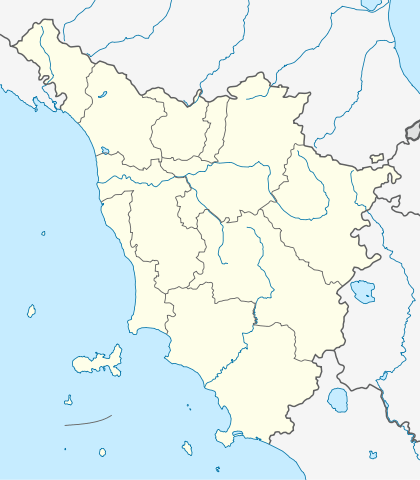Borgo a Mozzano
Borgo a Mozzano is a town and comune in the province of Lucca, in northern Tuscany (Italy), located on the Serchio River.[3]
Borgo a Mozzano | |
|---|---|
| Comune di Borgo a Mozzano | |
 Ponte della Maddalena. | |
 Coat of arms | |
Location of Borgo a Mozzano 
| |
 Borgo a Mozzano Location of Borgo a Mozzano in Italy  Borgo a Mozzano Borgo a Mozzano (Tuscany) | |
| Coordinates: 43°58′43″N 10°32′45″E | |
| Country | Italy |
| Region | Tuscany |
| Province | Lucca (LU) |
| Frazioni | Anchiano, Cerreto, Diecimo, Dezza, Gioviano, Valdottavo, Cune, Corsagna, Tempagnano, Oneta, San Romano, Domazzano, Chifenti, Rocca, Piano Della Rocca, Montrone, Partigliano |
| Government | |
| • Mayor | Patrizio Andreuccetti |
| Area | |
| • Total | 72.2 km2 (27.9 sq mi) |
| Elevation | 97 m (318 ft) |
| Population (31 March 2017)[2] | |
| • Total | 6,978 |
| • Density | 97/km2 (250/sq mi) |
| Demonym(s) | Borghigiani |
| Time zone | UTC+1 (CET) |
| • Summer (DST) | UTC+2 (CEST) |
| Postal code | 55023 |
| Dialing code | 0583 |
| Patron saint | Madonna delle Grazie (Our Lady of Grace) |
| Website | Official website |
History
The town is mentioned for the first time in 879, when a document mentioned one place In loco Mozzano prope Decimo. Later it was held by the Soffredinghi family, and then by the Republic of Lucca.
After the end of the Lucchese independence, it was part of the Grand Duchy of Tuscany and, from 1860, of Unified Italy.
Main sights

Borgo a Mozzano is dominated by the presence of Ponte della Maddalena also called "del Diavolo" (Devil's Bridge). The Devil's Bridge is located on the SP2 one kilometer north of downtown. The bridge's majestic structure attracts hundreds of tourists every year.
The Gothic Line, a German Second World War military defence line, passed through the comune. Sections of this fortification are well preserved and guided tours of the interior can be arranged.[4]
The church and convent of San Francesco is based in Borgo a Mozzano, a monastery which now houses a home for the elderly.[5] The 12th-century church of San Martino in Greppo, Borgo a Mozzano is located in the Diecimo district of the comune.
The 19th-century suspension bridge, Ponte delle Catene, Bagni di Lucca or Bridge of Chains, links Chifenti in Borgo a Mozzano to Fornoli in the neighbouring comune of Bagni di Lucca.[6]
Transportation
The town of Borgo a Mozzano is centrally located between the Garfagnana and the Lucchesia, and can be easily reached by car with the SS12 "Brennero" or the SP2 "Lodovica". The nearest major airport (50 min drive) is the Galileo Galilei International Airport of Pisa.
The comune has two train stations, Borgo a Mozzano and Diecimo-Pescaglia, which are served by the line Lucca-Aulla. Also, an infrequent bus system connects Borgo a Mozzano with the city of Lucca and the rest of the Garfagnana. Bizarrely, fares cannot be purchased on the bus, making it difficult to use. You can make a journey on the bus but often find you cannot return the same day due to lack of services. Busses are not used by tourists due to being so infrequent and not knowing where to purchase the fares.
Notable natives and residents
- St. John Leonardi, founder of the Clerks Regular of the Mother of God of Lucca[7]
- Giuseppe Antonio Luchi, painter
- Nicolò Fazzi, footballer
- Federico Mattiello, footballer
Asteroid
Asteroid 44717 Borgoamozzano, discovered by Italian amateur astronomer Sauro Donati in 1999, was named in honor of the town.[3] The official naming citation was published by the Minor Planet Center on 27 August 2019 (M.P.C. 115894).[8]
References
- "Superficie di Comuni Province e Regioni italiane al 9 ottobre 2011". Istat. Retrieved 16 March 2019.
- "Popolazione Residente al 1° Gennaio 2018". Istat. Retrieved 16 March 2019.
- "JPL Small-Body Database Browser: 44717 Borgoamozzano (1999 TY6)" (2019-05-11 last obs.). Jet Propulsion Laboratory. Retrieved 26 September 2019.
- "The Gothic Line at Borgo a Mozzano". Turislucca. Retrieved 8 August 2017.
- Convento Borgo http://www.conventoborgo.it/. Retrieved 12 November 2017. Missing or empty
|title=(help) - "What to see and do in Bagni di Lucca". Visit Tuscany. Retrieved 28 December 2017.
- "San Giovanni Leonardi". Santi Beati. Retrieved 8 August 2017.
- "MPC/MPO/MPS Archive". Minor Planet Center. Retrieved 26 September 2019.
External links
- Official website (in Italian)
- Borgo a Mozzano tourist information website (in Italian)